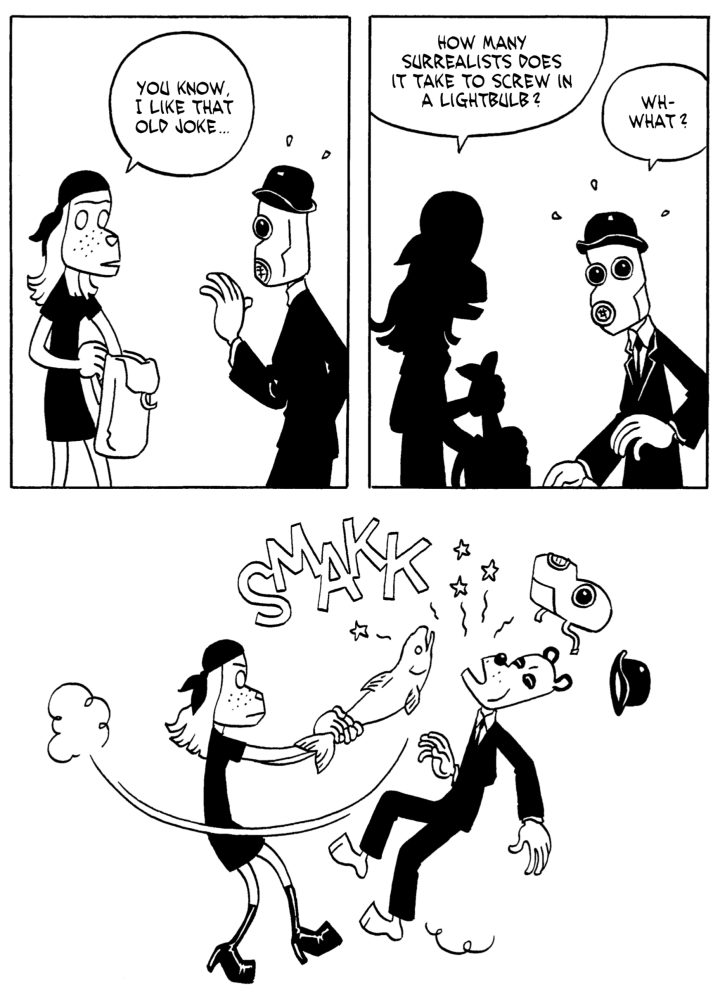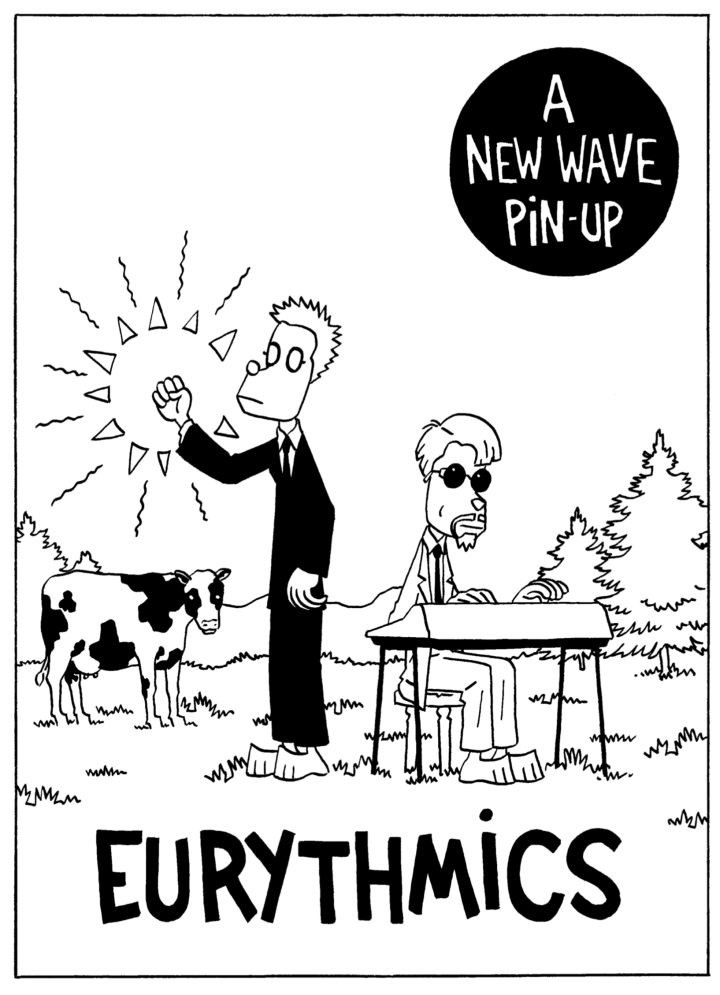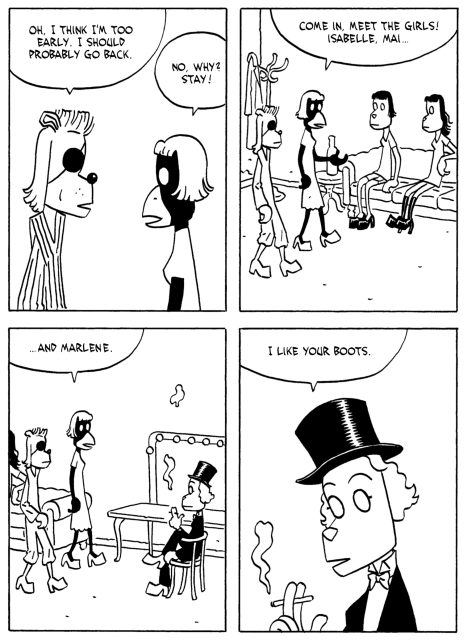So, let’s have a word for Jason. Not the guy with the hockey mask - I don’t think. Wouldn’t that be a twist!
 panel from Death in Trieste by Jason (Fantagraphics 2025)
panel from Death in Trieste by Jason (Fantagraphics 2025)
He’s been around for a while, quietly stacking up a formidable heap of books. I just checked: he’s been published in this country for almost twenty five years. His first book in English was 2001’s *Hey Wait . . . *I’m not going to say the book made a tremendous splash when it appeared, because Jason isn’t the kind of cartoonist you can imagine ever making “a big splash.” His virtues are quiet. He slid into the pool without so much as a ripple, an…
So, let’s have a word for Jason. Not the guy with the hockey mask - I don’t think. Wouldn’t that be a twist!
 panel from Death in Trieste by Jason (Fantagraphics 2025)
panel from Death in Trieste by Jason (Fantagraphics 2025)
He’s been around for a while, quietly stacking up a formidable heap of books. I just checked: he’s been published in this country for almost twenty five years. His first book in English was 2001’s *Hey Wait . . . *I’m not going to say the book made a tremendous splash when it appeared, because Jason isn’t the kind of cartoonist you can imagine ever making “a big splash.” His virtues are quiet. He slid into the pool without so much as a ripple, and he’s been in our midst every since. Oh, that’s Jason. Without even blinking he released twenty-one books between 2001 and 2015 - some of those were compilations of previous work, but that in itself is notable. He sells well enough for bundling. He’s slowed down some in the last decade, true, but that’s only relative to one of the defining hot streaks of the early century.
Like I say, moving in to the canon with nary a ripple. One moment there was no Jason, the next there was, simply a fixture of the landscape, for better or for worse. If you’d have asked me to guess how long Jason had been among us, I wouldn’t have guessed two and a half decades. He doesn’t feel like a monolith with a quarter century under his belt. The work itself is modest, intentionally, seemingly slight, and yet it all adds up. Seen from a distance, a hot streak to rank with the very best.
*Hey Wait . . . *was an excellent place to start for the man. The book is built on the idea of absence, elision. Something missing, near the heart but undefined. As it would turn out a defining sensation of the coming era, even in the quieter moments: something is missing. Something is just out of reach. It matters a lot but you can’t quite put it into words.
Surrealism is a hard thing to put into narrative. Not to say it hasn’t been done, certainly, but the demands of building a story often stand athwart the demands of maintaining a studied tone of unreality. Kafka managed, and for his troubles with gifted with an adjective all his own. Often misapplied, but oh well. At least he’s famous forever, which is all he ever wanted, and if that’s not Kafkaesque I don’t know what is. But for his virtues, Kafka didn’t know how to end a book. He managed the trick once, with *The Trial, *which ends with the protagonist being murdered with a rock (sorry to spoil The Trial, which turns 100 this year). It’s not really the kind of book where knowing that going in will effect your enjoyment overly much.
 page from Death in Trieste by Jason (Fantagraphics 2025)
page from Death in Trieste by Jason (Fantagraphics 2025)
Kafka was a misanthrope, the archetype of twentieth century literary malcontent. Jason by contrast isn’t a malcontent. On the contrary, he does genuinely seem to like human beings, even if everyone in his stories is actually a dog. Yeah, it’s one of those things. Like Blacksad. You know Blacksad, noir crime stuff with dog people and whatnot. Not as depressing as Elephantmen, which takes the funny animal motif as far into grimdark as you’d want to go. But proof that people still find inspiration putting funny animals through very unfunny stories.
There’s nothing grim in Jason, not outside the occasional nods to real-life history. Occasional notes of the macabre, sure, nods to horror imagery and motif, but no misanthropy. The adventure occasionally gets rough but never gratuitously so. Action, when it arrives, is understated and functional. He doesn’t shy from it, but neither does he bend to its rhythms. Whimsical, yes - there’s a loaded word, in 2025. Nothing frivolous. Whimsy without silly. A load-bearing whimsy, a whimsy to accommodate great tragedy. Whimsy with occasional nods to the rise of fascism. The lightest touch conceivable to sell occasionally difficult material.
That’s a neat trick. Jason leaves you with a lot to think about it. He doesn’t give you all the answers. He doesn’t even ask a lot of questions. You get a story, nothing less. But half the panels appear to be missing and the effect is often downright eerie.
We’re here today to talk about a recent triptych, Death in Trieste, from longtime American publisher Fantagraphics. A book largely but not entirely about the art of the first part of the century, the pre-war and inter-war culture annihilated by the aforementioned rise of fascism. David Bowie shows up in this one, has a “thing” with Marlene Dietrich. To which you ask, is David Bowie also a dog? Yes, David Bowie is a dog. He’s also walking around like Ziggy Stardust just on the reg. Not hard to pick out of a lineup, even given the dog part.
 page from Death in Trieste by Jason (Fantagraphics 2025)
page from Death in Trieste by Jason (Fantagraphics 2025)
There’s a through line across these three stories, though you may have to squint to make it fit together. Bowie is a presence across all three - a cameo in the first, more of a player in the second and third parts. The first glances at a conspiracy involving the work of Rene Magritte, the second begins with the death of Rasputin and looks at the early days of Dada, amidst the malaise of the immediate postwar and haunted in advance by the ghosts of genocides yet to come. The third features a consortium of eighties new wave bands - Ultravox, the Eurythmics, and The Cure - working with David Bowie to save the world from an asteroid. Do they succeed? I guess you’ll have to read the book to find out.
Formally Jason is quite consistent, presenting a fixed regime of four rectangular panels per page. The story has a staccato rhythm, one damn thing after another, events unfurling like the ticking of a clock, with only a couple variations throughout. A woman hits someone with a fish in the first chapter and that takes up the whole bottom of the page, and we get pinups for two of the aforementioned new wave bands - so, yes, there is a Eurythmics pin-up. Yes, they are dogs. They’re fighting a group of Crowley-inspired mystics.
 page from Death in Trieste by Jason (Fantagraphics 2025)
page from Death in Trieste by Jason (Fantagraphics 2025)
The first part of the twentieth century saw a great surge in belief in mystics and psychic powers, alongside the unceasing avalanche of terrible news. Not unrelated things! Dada was a response to great tragedy experienced across the scale of an entire society, as was the proliferation of psychics and other charlatans. Not an unfamiliar sensation, actually: sometimes the news is so bad people prefer to step out of reality, either wallowing in brainrot slop or paying someone a lot of money to reassure them that their loved ones are resting gratefully in the next world. And sometimes if you play pretend with enough eagerness you can be visited by real revenants, fresh in their striped uniforms from the camps.
 page from Death in Trieste by Jason (Fantagraphics 2025)
page from Death in Trieste by Jason (Fantagraphics 2025)
So, yes: David Bowie travels through time to 1920s Germany, encounters Dada, sleeps with Marlene Dietrich, foreshadows the Holocaust, gets in a spaceship and goes to shoot an asteroid out of the sky. That actually sounds like something you’d have read in a pre-Vertigo DC “Mature Readers” book, Hellblazer or *Shade the Changing Man, *only delivered in Continental deadpan. Jason’s line is sparse but certain. A very simple style, which is not to say simplistic, rather: precisely as simple as one can manage without sacrificing clarity. Just enough lines to communicate the presence of David Bowie, not one jot more. No hatching for shade, just the occasional check pattern or speaker box, either clean lines or spotted blacks: same as it ever was.
Is it good? Yes, very, of course. Hard to argue with that consistency, or that thoughtfulness. Were I a churl - and good thing I’m not! But boy, if I were . . . it might be sorely tempting to end this review by turning that same consistency against him, all jiu-jitsu like. To which I say: fooey to such churlishness. We should all be so lucky as to have twenty-five years of extraordinarily consistent track record held against us in the virtual pages of the paper of record - *like, I dunno, uhhh, maybe you could do something besides dogs? *Clearly he likes the dogs. Let him do the dogs, the dogs seem to be working for him.